GamesRadar+ Verdict
Atomic Heart has a lot of big ideas, but it doesn't do a good enough job with the basics. With an incomprehensible storyline, weightless combat, and frustrating first-person platforming, Atomic Heart is left to stand in the shadow of the video games that so clearly inspired it.
Pros
- +
Big ideas
- +
Interesting concepts
- +
Beautiful artistic direction
Cons
- -
Messy story
- -
Lackluster combat
- -
Infested with bugs
Why you can trust GamesRadar+
Atomic Heart front-loads its most fascinating concepts. There are floating Soviet laboratories in the sky, home to a networked artificial intelligence which could signal the evolution of human consciousness; a veteran USSR operative who can't recall his past, and an army of rampaging robots designating the populace of Facility 3826 as enemy combatants after a software malfunction. Atomic Heart's opening hours are busy, but enthralling – recalling fond first visits to worlds like City 17, Dunwall, and Rapture. Sadly, Mundfish isn't able to weave these loose threads into anything functional.
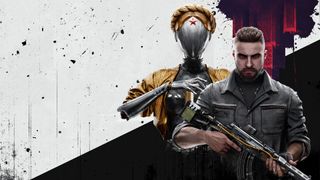
Release date: February 21, 2023
Platform(s): PS5, PS4, PC, Xbox Series X, Xbox One
Developer: Mundfish
Publisher: Focus Interactive
Atomic Heart lacks nuance in everything that it does, which works to its detriment as further ideas are layered into the mix. In comes the commentary on the eroding lines between communism, capitalism, and socialism, too complex to be explored in short conversations between an ambivalent action hero and his talking glove. Fetch quests build around outrageously convoluted lock and key systems, signaling an artificiality to the story and spaces. New enemy types emerge as the result of a symbiosis between bioengineered plants and human corpses. The dead start to speak. Audio diaries amass. Weapon vendors are uncomfortably, audibly horny for resources. And through it all, Agent P-3 has the emotional maturity and biting wit of a teenager who just discovered Reddit and the concept of internet anonymity.
Lost the plot
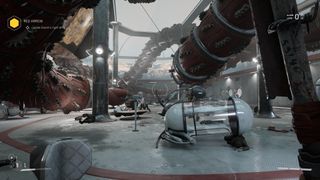
What if, rather than receding from the world stage in the aftermath of World War 2, the USSR rose to conquer it through the development of advanced robotics and astronautics? Conceptually, It's an interesting thought experiment. Efforts to explore alternative histories aren't uncommon in the science-fiction shooter landscape; Prey sought to actualize an accelerated Space Race, while a pair of Wolfenstein adventures let us quash a resurgent Nazi Germany.
Crucially, MachineGames found so much success with The New Order and The New Colossus because we viewed these twisted timelines through the stoic eyes of B.J. Blazkowicz – a steadied hand amongst oversized carnage. Perhaps the greatest mistake Atomic Heart developer Mundfish makes is with how it handles its protagonist, Major Sergei Nechaev – a wholly unremarkable avatar of destruction, stumbling through the launch of Communism 2.0 with such an aversion to curiosity that I can't help but share in his brutish animosity to it all.
Have you ever ordered a sci-fi book from the backpages of a pulp magazine (or to a Kindle via Amazon, such is the future we find ourselves in) because you were drawn in by the promise of the cover art, only to find the internals lacking? Disappointment festers when informed expectation collides with unfulfilled potential. That's something I felt keenly by the time I was being thrown from one anticlimactic boss battle to the next, struggling to unpack layering lines of exposition as mistakenly-amplified audio tracks drowned dialogue and subtitles shrunk into the environments. Here's the thing though: Atomic Heart has one hell of a beautiful front cover. Mundfish has engineered an undeniably gorgeous playspace, the sort of world that you'll want to get lost in – plot, pacing, and narrative design be damned. At least for a time anyway.
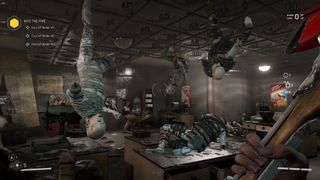
I encountered a plethora of frustrating bugs throughout my time with Atomic Heart. Whether it was collected resources sticking to the side of the UI, swelling audio which refuses to subside after combat concludes, enemies getting caught in the environment, powers refusing to switch, and so on. Additionally, while Atomic Heart is certainly a good-looking game for the most part, the quality of some of its visual assets (particularly in cutscenes) really decays towards the backend of the story.
Despite the appearance of a Deus '0451' Ex reference before you've even had the opportunity to work out whether you want to invert the thumbsticks, Atomic Heart was never pitched as an immersive sim. Even still, I wish that Mundfish better capitalized on the wondrous world it engineered. You're given the space to explore environments, which are largely gated by frustratingly oblique lockpicking minigames and the terms outlined by quest progression. You can idle forward gradually if you want to – in both the core missionset (predefined facilities that you move through linearly) and the wastelandish open-area which connects the campaign together. Given this framing, I was surprised to find so little to do, see, or find. That there was no life – only death and decay spread throughout every nook and cranny.
Consider the worlds put forward by BioShock – the underwater odyssey of Rapture; and Columbia's floating castle in the clouds. What these environments lack in points of interactivity, they make up for with a stunning sense of time and place. They feel lived-in, as if they existed long before you clicked in from the start menu, and will continue to do so long after you leave it all behind. Conversely, Atomic Heart, with its empty laboratories, pristine museums, and crumbling underground facilities, feels somewhat hollow – a 4K facade dressed in a stunning ambient lighting model.
Robot revolution

Even with its messy narrative frame and fractured world design, I had high hopes for the combat. Inspect the underlying mechanical design of Atomic Heart, and it's possible to detect echoes of influence from a distinct set of first-person adventures. Atomic Heart takes aim at the physical-presence exhibited throughout Half-Life 2, the heavy-melee combat that became a trademark of the Dying Light games, the caustic gunplay of Wolfenstein and Doom, and the interweaving powersets that defined BioShock. This may be the debut video game from Mundfish, a studio founded just five years ago, but Atomic Heart arrives with big ambitions.
And Atomic Heart certainly has some nice ideas – an intuitive approach to looting is appreciated, so too is an imaginative approach to enemy spawns, as spores reanimate mangled corpses and androids stalk bloodied halls close to their assigned workstations. However, it fails to pair them with a forward-thinking approach to the basics. I found movement to be jittery around the edges, melee combat is ponderous, the firearms lack distinction, and tracking enemies is a hassle.
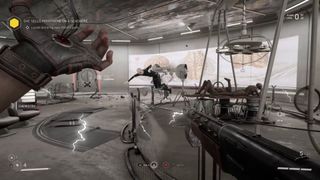
Atomic Heart does an exceptionally poor job of explaining the intricacies of its combat systems. One area I wish Mundfish had emphasized further concerns the use of elemental and energy damage. Special elemental cartridges can be installed onto weapons, imbuing them with the power of fire, ice, and electricity – an interesting wrinkle if you're trying to make things more visually spectacular. It's also possible to accumulate energy with melee weapons, and discharge it to help hold enemies at bay; an interesting idea, though the less time spent fighting with floaty clubs and axes the better.
Ammunition becomes plentiful by the time Atomic Heart completely loses sight of the story it's trying to tell, allowing you to reliably hold hordes of enemies at bay from a distance, but there's a severe focus on melee before you reach that point. Initially, the androids can be relentless threats, shoving you into corners of which you have little ability to escape. Atomic Heart has a dodge function, but what it really needs is a block – there's little back and forth to encounters, making it feel as if you are robotically, weightlessly, exchanging blows in turn until something hits the ground.
The expanding set of Polymer powers do introduce some variety to combat, although the visual spectacle can only arrest attention for so long. Shok chains electric bolts through metal chassis, Mass Telekinesis thrusts rooms of enemies into the air, and Frostbite can freeze foes with jets of ice. Polymer Throw is designed to help you chain these abilities together, an accelerant which heightens elemental effects of anything it touches with expressive results. While entertaining enough when used sparingly, the powerset isn't diverse or intuitive enough to really change the cadence of combat. I routinely encountered a bug whereby I couldn't switch between the two powers I had installed; most of the time, I simply relied on Mass Telekinesis for crowd control while I drained the ammunition reserves of a quietly chattering Kalashnikov rifle.
Ramble on
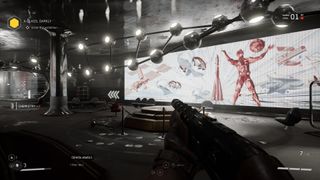
Among the most baffling creative decisions that Mundfish made surround the inclusion of first-person platforming and capitulation toward a trend of open world distraction. I can count on two hands the number of first-person shooters that handle platforming from this perspective well, and Atomic Heart is not one of them. While the framerate holds at a steady 60 frames-per second, player animation isn't fluid enough to support intricate movement. The sections of play where you're forced to navigate between yellow beams and shifting platforms are among the most frustrating, particularly as shaky collision detection will often push you away from elements in the environment that you should be able to reach. And heaven forbid you invest in the ability which mitigates fall damage, causing P-3 to combat roll off of platforms that he should hit with sure footing.
Mercifully, platforming is kept to a (relative) minimum through Atomic Heart's five main facilities, with much of it held for the test sites scattered across the banal open world – padding between campaign missions. These puzzle rooms are designed to make intuitive use of your Polymer Powers, but in reality are exercises in frustration mitigation. While optional, many of Atomic Heart's more interesting weapon upgrades are hidden within these underground labs, and you'll want those to help breathe a little life into the combat – and to make all that rummaging through office desks and kitchen cabinets for valuable resources and crafting recipes worthwhile.
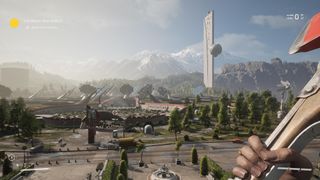
Atomic Heart is a messy video game with big ideas and a desperate need for refinement
Shooters with this style of crafting economy rely on a steady escalation of power – you begin weak, and gradually become more of a threat as six types of collected metal are exchanged for new ways to shoot and slice through enemies. Sadly, I never found (or was allocated, Atomic Heart doesn't make this clear) the crafting recipes for two of the more interesting weapons, nor was I ever able to acquire even a single Neuromodule after 20 hours of playtime – that's the resource necessary to craft some of the otherworldly weapon effects seen in much of the pre-release material.
Atomic Heart lacks focus. It's a messy video game with big ideas and a desperate need for refinement, and further optimization. This is perhaps best reflected in the decision to dilute the linear nature of the core campaign with a wide-open space to explore. There's exceptionally little to see in this sprawling area, which is populated with a small set of repeating houses, one model of vehicle that you can careen into patrolling enemies, and an unwieldy alarm-detection system that often leaves you battling waves of androids with little reprieve. Atomic Heart wants to be a lot of things all at once, and while that ambition is certainly commendable, Mundfish isn't able to execute its ideas with any consistency or clarity.
Atomic Heart was reviewed on PS5, with a code provided by the publisher
More info
| Genre | FPS |

Josh West is the UK Managing Editor of GamesRadar+. He has over 10 years experience in online and print journalism, and holds a BA (Hons) in Journalism and Feature Writing. Prior to starting his current position, Josh has served as GR+'s Features Editor and Deputy Editor of games™ magazine, and has freelanced for numerous publications including 3D Artist, Edge magazine, iCreate, Metal Hammer, Play, Retro Gamer, and SFX. Additionally, he has appeared on the BBC and ITV to provide expert comment, written for Scholastic books, edited a book for Hachette, and worked as the Assistant Producer of the Future Games Show. In his spare time, Josh likes to play bass guitar and video games. Years ago, he was in a few movies and TV shows that you've definitely seen but will never be able to spot him in.

